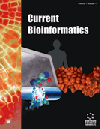- Home
- A-Z Publications
- Current Bioinformatics
- Previous Issues
- Volume 18, Issue 3, 2023
Current Bioinformatics - Volume 18, Issue 3, 2023
Volume 18, Issue 3, 2023
-
-
Drug Design and Disease Diagnosis: The Potential of Deep Learning Models in Biology
More LessEarly prediction and detection enable reduced transmission of human diseases and provide healthcare professionals ample time to make subsequent diagnoses and treatment strategies. This, in turn, aids in saving more lives and results in lower medical costs. Designing small chemical molecules to treat fatal disorders is also urgently needed to address the high death rate of these diseases worldwide. A recent analysis Read More
-
-
-
Predicting COVID-19 Severity Integrating RNA-Seq Data Using Machine Learning Techniques
More LessA fundamental challenge in the fight against COVID-19 is the development of reliable and accurate tools to predict disease progression in a patient. This information can be extremely useful in distinguishing hospitalized patients at higher risk for needing UCI from patients with low severity. How SARS-CoV-2 infection will evolve is still unclear. Methods: A novel pipeline was developed that can integrate RNA-Seq data from different Read More
-
-
-
Identifying Diagnostic Biomarkers of Breast Cancer Based on Gene Expression Data and Ensemble Feature Selection
More LessAuthors: Lingyu Li, Yousif A. Algabri and Zhi-Ping LiuBackground: In recent years, the identification of biomarkers or signatures based on gene expression profiling data has attracted much attention in bioinformatics. The successful discovery of breast cancer (BRCA) biomarkers will be beneficial in reducing the risk of BRCA among patients for early detection. Methods: This paper proposes an Ensemble Feature Selection method to screen biomarkers (abbreviated as EFSmarker) for B Read More
-
-
-
The Most Accurate Way of Predicting Birth Weight in China: Zhuo’s Formula
More LessAuthors: Wei Zhang, Hong Yang, Xiaoyi Guo, Yijie Ding, Jingbo Qiu and Xiaohua WangBackground: Pregnancy body mass index (BMI) influences fetal weight, yet no studies focused on the comparison of formulas’ predictive accuracy after considering it. Objective: This study aimed to find out the most accurate formula for predicting birth weight, especially in different BMI pregnant women. Methods: It is a prospective observational study. Using a convenient sampling, the participants who met the criteria fo Read More
-
-
-
Refining Protein Interaction Network for Identifying Essential Proteins
More LessAuthors: Houwang Zhang, Zhenan Feng and Chong WuAim: The study aimed to reconstruct the protein-protein interaction network for the identification of essential proteins. Background: In a living organism, essential proteins play an indispensable role in its survival and development. Hence, how to identify essential proteins from the protein interaction network (PIN) has become a hot topic in the field of bioinformatics. However, existing methods’ accuracies for identifying ess Read More
-
-
-
Drug Repositioning Based on a Multiplex Network by Integrating Disease, Gene, and Drug Information
More LessBackground: The research of new drugs is very expensive and the cycle is relatively long, so it has broad development prospects and good economic benefits to use validated drugs in the treatment of other diseases. Objective: The purpose of drug repositioning is to identify other indications for existing drugs. In addition to using disease and drug information for drug repositioning, other biomolecular information ca Read More
-
-
-
LPLSG: Prediction of lncRNA-protein Interaction Based on Local Network Structure
More LessAuthors: Wei Wang, Yongqing Wang, Bin Sun, Shihao Liang, Dong Liu, Hongjun Zhang and Xianfang WangBackground: The interaction between RNA and protein plays an important role in life activities. Long ncRNAs (lncRNAs) are large non-coding RNAs, and have received extensive attention in recent years. Because the interaction between RNA and protein is tissue-specific and condition-specific, it is time-consuming and expensive to predict the interaction between lncRNA and protein based on biological wet experiments. Objective: Read More
-
Volumes & issues
-
Volume 20 (2025)
-
Volume 19 (2024)
-
Volume 18 (2023)
-
Volume 17 (2022)
-
Volume 16 (2021)
-
Volume 15 (2020)
-
Volume 14 (2019)
-
Volume 13 (2018)
-
Volume 12 (2017)
-
Volume 11 (2016)
-
Volume 10 (2015)
-
Volume 9 (2014)
-
Volume 8 (2013)
-
Volume 7 (2012)
-
Volume 6 (2011)
-
Volume 5 (2010)
-
Volume 4 (2009)
-
Volume 3 (2008)
-
Volume 2 (2007)
-
Volume 1 (2006)
Most Read This Month
Article
content/journals/cbio
Journal
10
5
false
en


